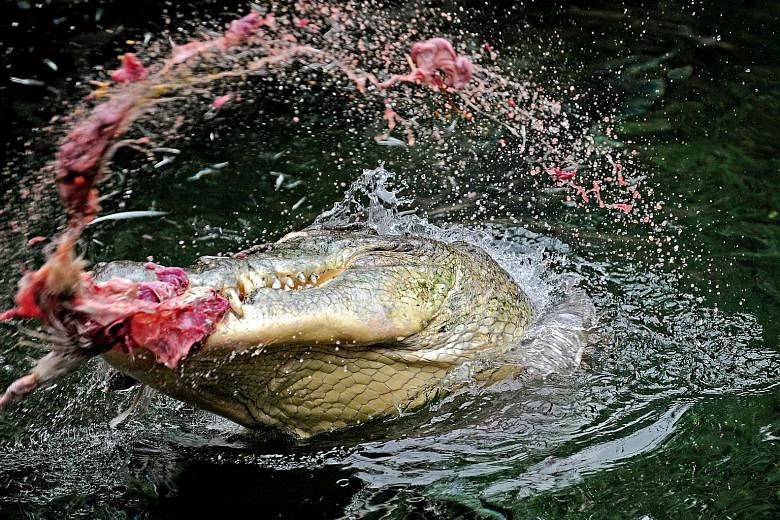In an unusual political stunt in Australia this week, a state MP from Queensland, Mr Shane Knuth, released a graphic photograph which showed a crocodile devouring a family's pet dog in a creek near their home.
Mr Knuth used the image to urge the Queensland Government to conduct a cull of crocodiles from populated areas. He said the crocodiles could frighten off potential tourists, noting that Queensland is highly dependent on tourism and attracts 22 million visitors a year.
"It's time to bring back the balance and prioritise human safety over crocodiles," he said.
"People come to Queensland to enjoy sunshine and beaches, but the image they're seeing now is crocodile attacks and crocodile signs everywhere.
"This is a very poor message to promote to international tourism."
The controversial call for a cull, backed by some locals and councillors, followed several recent deadly attacks on humans in the state's north.
On March 20, the body of Mr Warren Hughes, 35, was found near the town of Innisfail after he was apparently attacked by a 4m crocodile while spear fishing.
The authorities later found the suspected crocodile and killed it - a practice that is conducted only for individual crocodiles deemed a specific threat or problem.
Just a day earlier, an 18-year-old, Lee De Paauw, was mauled after he jumped into a river in Innisfail. He survived with broken arm bones and gashes.
An onlooker, Ms Sophie Paterson, told Channel Nine: "I've never heard a guy scream like that. There was a lot of blood, a lot of bone."
The attacks prompted fierce debate about whether to cull the creatures, particularly around populated areas or places visited by tourists. Critics say there is little or no evidence that culls will reduce deaths and that the best way to prevent attacks is to ensure that people stay away from dangerous lurking grounds.
-
Steering clear of the reptiles
-
Australia has more than 100,000 deadly saltwater crocodiles, including many in popular tourist areas across northern Queensland and the Northern Territory.
Despite a recent increase in attacks, fatalities are relatively rare.
Most experts believe that people, if careful, can confidently limit the risk.
Here are some tips.
•Crocodile habitats in Australia are typically marked with warning signs.
•Do not enter the water or approach the water's edge. Be extra careful around water at night.
•Avoid camping within 50m of the water's edge or going out on small boats or dangling your legs over the sides of boats.
•Campers are advised to dispose of food scraps away from their campsite.
•Never provoke, harass or interfere with crocodiles - even small ones.
•Never feed crocodiles - it is illegal and dangerous.
•Crocodiles are ambush predators and most attacks are made in an area which has never had one before.
•Be extra vigilant during breeding season from September to April.
An expert on reptiles - Professor Lin Schwarzkopf, from James Cook University's Centre for Tropical Biodiversity and Climate Change - said culls were expensive and intrusive but not necessarily the most effective way to prevent attacks.
"Solutions that may seem the most obvious do not always work," she told The Sunday Times. "Crocodile attacks are a function of the numbers of crocodiles, the numbers of people and the numbers of people that are in crocodile areas. It is difficult to say which of these is causing increases in attacks."
In the past 46 years, there have been at least 35 fatal crocodile attacks in Australia, including 23 in the Northern Territory, 10 in Queensland and two in Western Australia.
But the attacks - involving saltwater crocodiles - have become more common in recent years.
In the past five years, there have been 10 fatal attacks.
Some have linked the increase to the dramatic rise in the crocodile population since they were declared a protected species in the early 1970s.
Australia is now believed to have more deadly saltwater crocodiles than any other country.
In the Northern Territory, there are now believed to be 100,000 saltwater crocodiles, up from about 3,000 when protections were imposed in 1971.
Queensland, which declared them protected in 1974, is conducting a survey but is believed to have a substantial crocodile population, albeit smaller than that in the Northern Territory.
The protections were introduced following the near wipe-out of the nation's crocodiles due to widespread unregulated hunting.
Some commentators and politicians have suggested profiting from a cull by selling safari permits to hunters to raise revenue.
Others have proposed allowing Aborigines to hunt the crocodiles.
The Queensland government has resisted a cull but last month introduced a new plan to ensure crocodiles do not threaten populated areas. The plan created six zones of varied danger levels. In some populated areas, barriers will be used and any crocodiles would be removed to farms or zoos.
In less populated areas, crocodiles larger than 2m would be "encouraged to leave" but could be removed if deemed dangerous.
"(The) government is well aware there are serious public safety concerns associated with croc country but we want to be guided by science - not emotion," said Queensland's Environment Minister, Mr Steven Miles, in a statement.
Most experts say crocodiles will not travel to prey on food, so the best way to avoid attacks is to prevent people from swimming in dangerous waters or camping close to river banks.
The Northern Territory government also opposes culls, saying crocodiles cover vast distances on land and water and killing them will not guarantee an area is "crocodile-free". Rangers in the Northern Territory use traps and harpoons to kill or relocate about 250 crocodiles a year.
"Removing one crocodile may simply create more space for the other crocodiles that already live there or allow new crocodiles to move into the newly vacated area," says the government's website.
Prof Schwarzkopf noted that culls could change the behaviour or male-female ratios of crocodiles and could potentially "make the problem worse".

